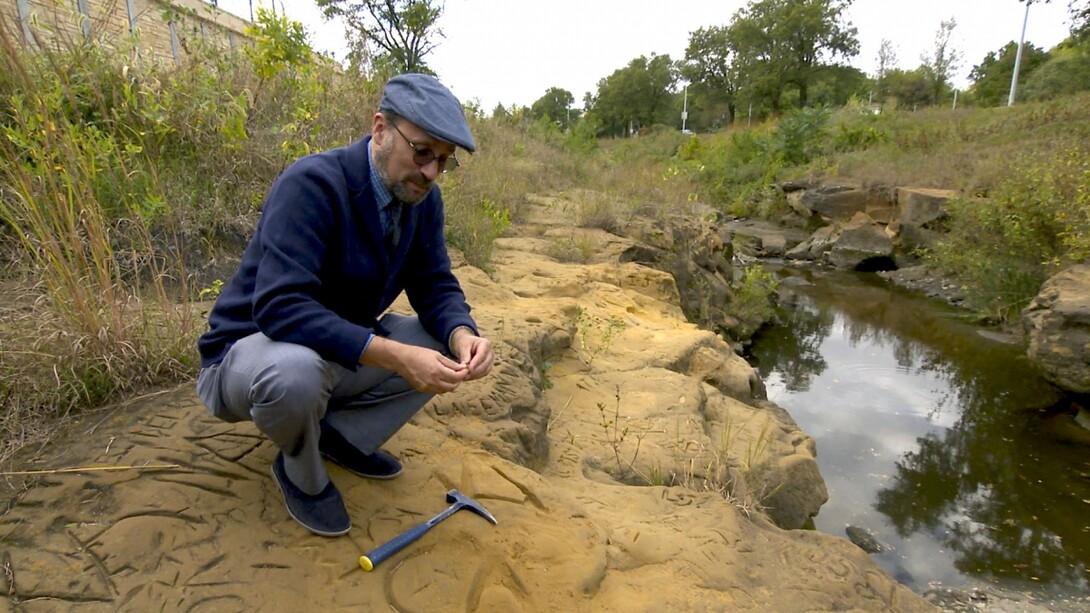
Lincoln, Neb. —Matt Joeckel’s profession gives him an exceptional perspective on Nebraska. As the state geologist and professor at the University of Nebraska-Lincoln’s School of Natural Resources, he studies practical matters such as carbon sequestration, rare earth elements and regional earthquake potential. But his work also gives him insight into the extraordinary depth of time that’s marked Nebraska’s existence on our planet.
Consider Nebraska’s ancient lava flows, as revealed by one of the thousands of cores in the Geological Sample Repository managed by the state Conservation and Survey Division (CSD). Joeckel is the director of CSD, Nebraska's service conducting a wide array of geological, geographic, water and soil surveys.
The lava flows contained in the Nebraska core sample “look just like younger lava flows,” Joeckel says, “like those on the Columbia Plateau in Washington.” But the Nebraska material stands out in a notable way — it is “much, much, much older — 1.1 billion years old.”
As a result, Joeckel says, Nebraska’s ancient lava flows “predate multicellular life on Earth.” At 1.1 billion years in the planet’s past, “we’re still hundreds of millions of years away from, as far as we know, the first multicellular life on Earth. What life existed on Earth at that time was all single-celled.”
The ancient rift system that provided that core “is directly underneath Lincoln and Omaha,” says Joeckel, who attended UNL, the University of Kansas, the University of Florida, and Iowa State University on his way to attaining his Ph.D. from the University of Iowa. “Most people are utterly unaware it exists. It is remarkable.”
That connection to the Earth’s deep past can be made “only by coring it, by drilling it.” That shows the importance of storing Nebraska’s extensive set of geologic cores, he says. “In a world in which so many things seem to be disposable, I would argue that, scientifically, throwing away cores would be like throwing away a Gutenberg Bible.”
Geology shows that what happens on the Earth’s surface has important, enduring connections to what’s happening beneath the surface, Joeckel says. “Just because it isn’t alive in the biological sense doesn’t mean the Earth isn’t dynamic.”
Consider the foundation of nutrition for agricultural crops. “Among the things that plants need are potassium, phosphorus, calcium, magnesium. Those all come from the solid Earth,” Joeckel says. “We can through a whole list of micronutrients too — iron, copper, boron, silicon, there’s a huge list. Those all come from the breakdown of rocks, ultimately, and that’s going on all the time.
“Let’s think of the oceans. The major ions dissolved in seawater — most of them are derived from the breakdown of rocks from on land. Sodium, calcium, potassium, magnesium — it’s remarkable. It’s almost poetic. Salts in the oceans, nutrients in soils on land — they’re derived from the breakdown of rocks in the solid Earth.”
Geology regularly unearths notable findings, says Joeckel, the senior associate director of UNL’s School of Natural Resources, but these explorations of “deep time,” across billions of years of planetary existence and change, also show how much remains to be discovered — and perhaps never will be discovered.
“For me personally, the idea of deep time is compelling,” he says, “not just in terms of producing research or getting grant money but in almost a mystical way. I’ve always been secretly fascinated more by what we don’t know than by what we do not. I’ve always been philosophically enthralled by what we may never know about Earth history. I like the idea that there are some things we’ll never know, or that perhaps no one will ever know, because that is powerfully revealing.”
Southeastern Nebraska provides an example. ”In the bedrock right around Lincoln,” Joeckel says, “we can find an unconformity that represents about 200 million years of missing sedimentary rock record, concretely, and then abstractly of missing time. Nebraska was here for that 200 million years. We just don’t have any record in terms of sedimentary rock.
“You can actually go along some places on the Platte River and put your hand on the contact, the physical contact, between the underlying rocks of Pennsylvanian Age, about 300 million years old, and overlying strata of the Dakota Formation Cretaceous Age, about 100 million years old.” Strata of earlier multimillion-year periods — the Cretaceous, Jurassic, Triassic and mid- to late Permian ages — were either never deposited in the area or were deposited and eroded.
At those locations, a present-day Nebraskan “can put your hand exactly at the point representing 200 million years of missing geologic record.” Such are the insights and opportunities that geology provides.
“Isn’t it fascinating, isn’t it compelling,” Joeckel says, “to think that we have no record for that interval of time? And we’re left to speculate or to guess or to dream or, scientifically speaking, to draw inferences from strata of those ages as they exist in places far away.”
“It’s things like that that still motivate me,” he says, “that still make me stop and consider, this really is a beautiful science. And it is.”
Geitner Simmons | IANR Media







